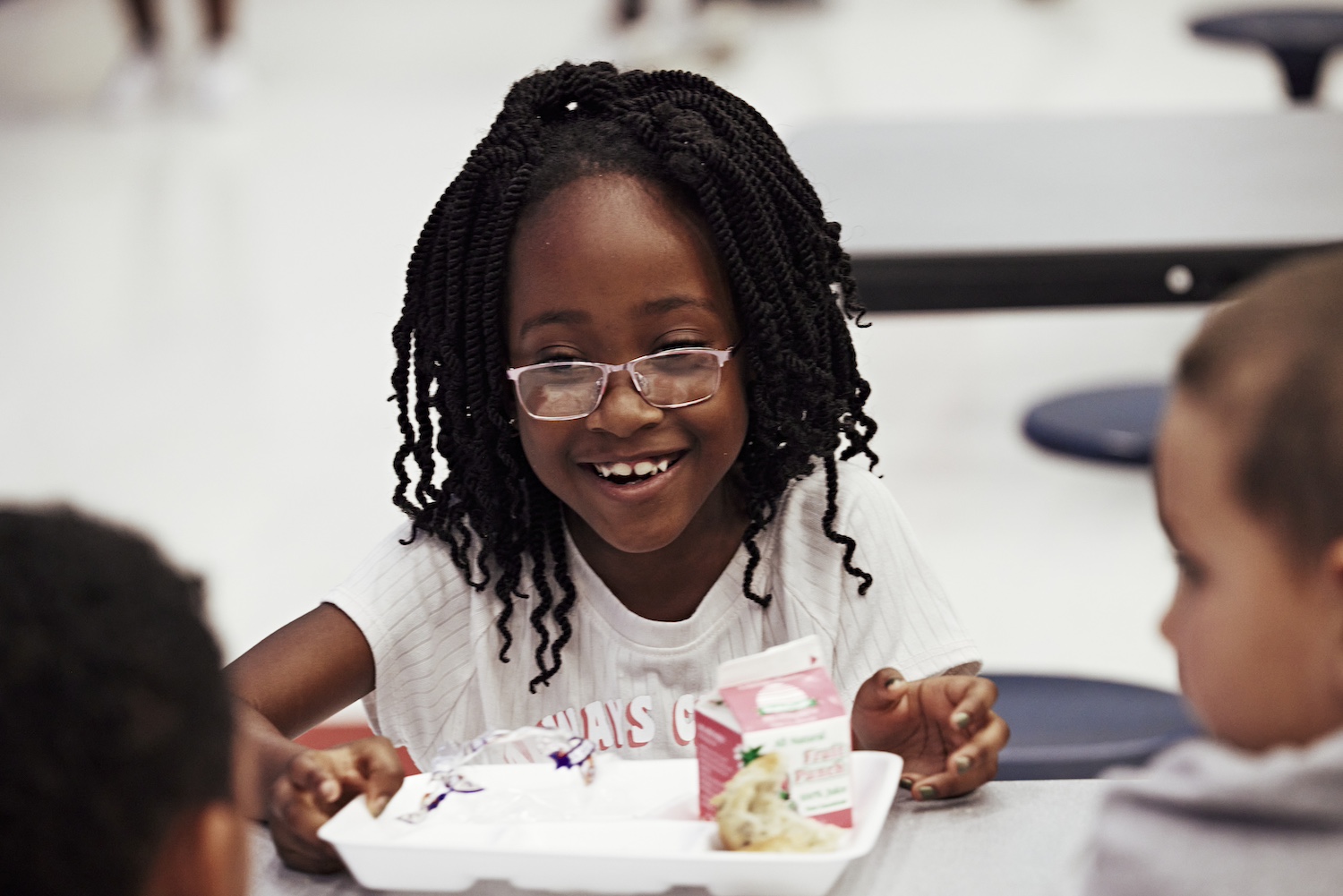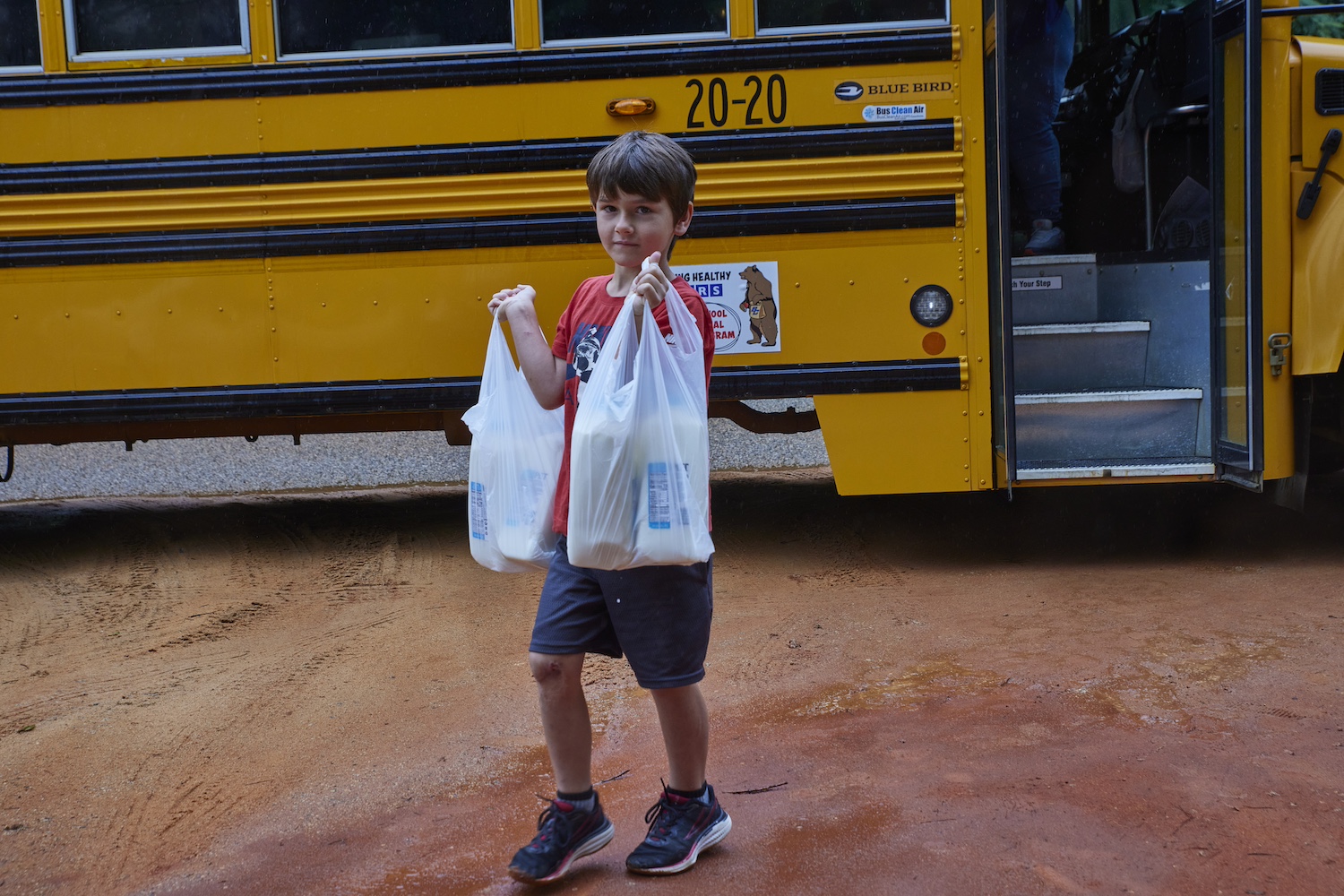
A student in Burke County, Georgia, opens a box of food they received from the recently-expanded summer meal program. (Image courtesy of No Kid Hungry.)
School meal programs are an essential part of fighting child hunger in the U.S., and the summer months are extra tough for the 20 percent of children who already don’t have access to enough food. Additionally, 41 percent of parents report having a hard time providing enough food during school breaks. While summer meal programs aim to help bridge that gap, only one in six eligible children benefit from it. That’s where the No Kid Hungry campaign comes in with its CEO Pledge to End Summer Hunger and the goal of raising participation in summer meal programs from 2.8 million children to 30 million.
“When you're eight, 12, 14, and your belly is empty, that's just incredibly difficult,” Charles Watson, the CEO of Tropical Smoothie Cafe, told TriplePundit about his participation in the pledge. “So those were the things that really hit me hard, in terms of, we've got to get involved here.”
As the head of a food service company, the program is also important for business, Watson said. “These are my future employees, and they're my future guests, right? They're both incredibly important people to me … Who doesn't believe that kids are the future of the country?”
Changes to the summer meal program
Developed in 2010, No Kid Hungry is a United States-based campaign run by the nonprofit Share Our Strength, which was created in 1984 as a response to the famine in Ethiopia. No Kid Hungry is currently focused on raising $50 million over the next three years to help implement bipartisan legislation passed in 2022 to expand the summer meal program, Anne Filipic, CEO of Share Our Strength, told 3p.
“It's the biggest investment and really [the biggest] change to nutrition programs in the country in 50 years,” Filipic said. The money raised will go to schools, local organizations and state agencies to ensure they have the funds to put the expanded program into action.
Lack of funding and accessibility are the primary reasons most children who qualify for summer meals don’t get them. Children are automatically eligible if they receive free or reduced-price school lunches or certain public benefits such as the Supplemental Nutrition Assistance Program (SNAP). Families who do not participate in these programs but meet the income requirements can apply separately.

Prior to the new legislation, the only way to access the summer meal program was for children to show up in person at designated meal sites and eat the lunches there. This situation created a burden for parents and caregivers, and it excluded children who didn’t have the means to travel to a meal site daily.
“I think everyone understands that that can be challenging for anyone but particularly if you're living in a rural area, if the meal site was 20 miles away, your parents are working, there's really no way that that kid can go,” Filipic said. “To now be in a place that those meals can be delivered, that they can actually be picked up, and you can pick up multiple meals at a time just completely transforms what it means in terms of the accessibility of this program.”
Filipic highlighted the example of Caroline County, Maryland, where she was able to ride along on deliveries to area with high levels of eligibility. “We were actually able to go door to door and hand out meals,” she said. “It’s very clear how that is just a total game changer and what that means for those kids, as opposed to having to travel miles and miles to get those meals.”
In addition to deliveries and multi-lunch pickups, the expanded summer meal program provides $40 per child for each month of summer — a total of $120 in grocery benefits. The funds, called Sunbucks, are available on electronic benefit transfer cards and can be used to buy cold foods and snacks the same way SNAP benefits are used.

Pledges and fundraising
As of July, No Kid Hungry has given almost $4 million to 215 partners nationwide, Filipic said. The funds are used to pay delivery drivers and buy equipment like delivery trucks and coolers, which will help provide more than 6 million meals to kids living in rural areas. So where are those funds coming from?
“Most CEOs, myself included, are going to make a personal donation,” Watson said. Tropical Smoothie Cafe also mobilizes its customers to give by rounding up or donating at the register, but the bigger dollars come from tapping into brand funds.
“[Consumers] want to see brands that are giving back," Watson said. "We have a smoothie on our menu called the Sunshine Smoothie, so we thought it was very appropriate for a Sunshine Smoothie to donate $1 of every one of those that we sell to No Kid Hungry … We have a three-pronged approach, but for every brand, they have different ways of going about it.”
Tropical Smoothie Cafe has raised more than $2.6 million since last summer, an achievement that the organization is very proud of, Filipic said. As a result, more brands and CEOs want to follow Watson’s lead.
“I think that point is really important because when I think of Jack in the Box, yes it's a brand, but to me, it's Darin Harris,” Watson said. “That's a guy I know who also does what I do in the restaurant business … Like any industry, we talk. We push each other on things … You get the groundswell of a CEO pledge. You get that good pressure [to participate].”
Limitations of the summer EBT program
Twenty-one million children in 37 states, five territories and three tribal nations are eligible for the Sunbucks EBT program this year, Filipic said. That number increases to 29 million when all 50 states participate.
But 13 states chose not to opt into the program, including Alabama, Mississippi, South Carolina, Georgia, Florida, Texas, Oklahoma, Iowa, Wyoming, South Dakota, Utah, Idaho and Alaska. All are led by Republican governors who claimed their state could not afford to distribute the federal funds or voiced opposition to so-called welfare benefits.
“What we focus on as a nonpartisan organization is that this is about kids,” Filipic said. “When a new policy is rolled out, often what people are focused on is the politics of it. But I think our experience is that as families start to benefit, as children start to benefit, as [they] realize that this can make the difference for a child in being fed in the summer and then starting the school year healthy and strong and ready to learn, as we continue to implement this program and lift up these success stories and highlight what it has meant for kids, the more … states will get on board.”

Collective action makes the difference
Childhood hunger in the U.S., and hunger in general, is the result of multiple factors, from poverty and a lack of sufficient safety nets to rising food prices to food deserts in vulnerable communities. Solving the problem therefore requires a multipronged approach. Collective action and summer meals can go a long way to help.
“This is what it will take to end childhood hunger in this country,” Filipic said. “A wide range from nonprofit organizations to policymakers to industry CEOs saying, ‘What can we do collectively … to make sure that no child goes hungry in this country?’”

Riya Anne Polcastro is an author, photographer and adventurer based out of Baja California Sur, México. She enjoys writing just about anything, from gritty fiction to business and environmental issues. She is especially interested in how sustainability can be harnessed to encourage economic and environmental equity between the Global South and North. One day she hopes to travel the world with nothing but a backpack and her trusty laptop.














